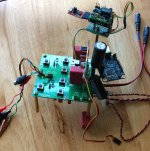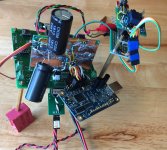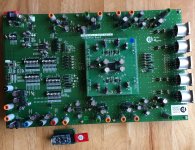Thought some folks might like to see a couple of pics of the ES9028PRO test dac that is being taken down for now to make room for the AK4499.
The basic dac board is a slightly modified diyinhk ES9028PRO board.
The rather large AD797 AVCC supply can be seen, with a couple of big +-15v filter caps added to give better bass response. The AD797 opamps still don't like too low ESR caps or they start to misbehave. The big ones shown in the pic are okay. There are also the usual .1uf X7R and 10uf tantalums for bypass at the socket.
Off to the side at an angle is the JLsounds I2SoverUSB providing master clocking for the dac chip as well as I2S signals.
On the very top of the stack is the Arduino borrowed from modded dac#2 project. (Today I have to continue work on putting together a new Arduino setup for use with new AK4499 eval board.)
The basic dac board is a slightly modified diyinhk ES9028PRO board.
The rather large AD797 AVCC supply can be seen, with a couple of big +-15v filter caps added to give better bass response. The AD797 opamps still don't like too low ESR caps or they start to misbehave. The big ones shown in the pic are okay. There are also the usual .1uf X7R and 10uf tantalums for bypass at the socket.
Off to the side at an angle is the JLsounds I2SoverUSB providing master clocking for the dac chip as well as I2S signals.
On the very top of the stack is the Arduino borrowed from modded dac#2 project. (Today I have to continue work on putting together a new Arduino setup for use with new AK4499 eval board.)
Attachments
What a board, not tiny LOL
Browsed through the doc and it seems to offer a lot of possibilities with a lot of connections, PS options, switches)... but also some constraints sadly.
I would like to use it without a computer piloting it and it seems even volume control access and other bits aren't available from this board :-(
One can't see easily on the pic, I seem to see some bridges and open points... can this board be easily modified, is there a way to pick the sound output as non symmetrical "before" the XLR connector (in fact before the entire stage), can BNC input connector be desolder easy to go for wires + RCA connector etc.
On the other, what matters first is the sound, as if that one sounds right then we should indeed start a new thread around the AKM, be it this board or chinese boards to come as these won't be long and might also be a modder alternative as it was the case for ESS.
On the other hand, if you can't extract enough sonic qualities from this board, I reckon it is probably not necessarly to start another thread.
Music will tell, thanks again for all this Mark, great to read you as ever
Claude
Browsed through the doc and it seems to offer a lot of possibilities with a lot of connections, PS options, switches)... but also some constraints sadly.
I would like to use it without a computer piloting it and it seems even volume control access and other bits aren't available from this board :-(
One can't see easily on the pic, I seem to see some bridges and open points... can this board be easily modified, is there a way to pick the sound output as non symmetrical "before" the XLR connector (in fact before the entire stage), can BNC input connector be desolder easy to go for wires + RCA connector etc.
On the other, what matters first is the sound, as if that one sounds right then we should indeed start a new thread around the AKM, be it this board or chinese boards to come as these won't be long and might also be a modder alternative as it was the case for ESS.
On the other hand, if you can't extract enough sonic qualities from this board, I reckon it is probably not necessarly to start another thread.
Music will tell, thanks again for all this Mark, great to read you as ever
Claude
It will be cool to see how it performs in voltage mode. If it isnt the same case as the Sabres sounding very ''lofi'' in voltage mode which the datasheet merely reflects as poorer but still fine THD+N, direct driving of high-z headphones with DAC output may be viable with that hefty output current
It will be cool to see how it performs in voltage mode.
Looks like it is intended to be a current-mode-only dac. It seems different from Sabre in some significant ways.
What a board, not tiny LOL
I would like to use it without a computer piloting it and it seems even volume control access and other bits aren't available from this board...
...can this board be easily modified, is there a way to pick the sound output as non symmetrical "before" the XLR connector (in fact before the entire stage), can BNC input connector be desolder easy to go for wires + RCA connector etc.
Time to learn I2C register programming, or wait until other's come up with controllers for this.
No need to replace in the input BNC for SPDIF, there are little RCA to BNC adapters on ebay, Amazon, etc.
There are opamp I/V converters on the dac daughterboard. Looks like current mode is the only option. From the I/V stages the differential dac output signals are passively filtered, then go the the differential output XLR connectors. From there one can attach one's own differential summing circuits, transformers, direct differential connections, or whatever else. Probably try the example differential summing circuits shown in the data sheet to see how they sound before trying anything more exotic.
The motherboard contains four reference voltage circuits for AKM's version of AVCC. They use opamp error amplifiers with pass transistors, one regulator circuit for each dac channel. The circuits can be bypassed to allow use with external reference voltage sources. IME, the quality of AVCC regulation for Sabre dacs is just as important as the output stage. Seems likely this dac will probably be similar in that respect.
Last edited:
Looks like it is intended to be a current-mode-only dac. It seems different from Sabre in some significant ways.
That would mean the Sabre doesnt need an I/V to work, but the AK4499 does? Though I think a ''voltage mode'' is something you dont want in the case of driving headphones, intended for simplified implementations of the chips.
That would mean the Sabre doesnt need an I/V to work, but the AK4499 does?
Approximately so. However, no point using Sabre in voltage mode even though it can be done, distortion is somewhere around 50dB worse that way. For most practical purposes, they are both current mode dacs.
AK4499 is up and running using JLsounds USB board for input and MCLK, and Arduino for control. PCM only today, will try to get to DSD tomorrow. 16/44 sounds quite good, very promising, and much easier to get good sound out of than a Sabre dac, IME, so far. This is with the most basic power supply configuration and no differential summing stage. Passively filtered I/V outputs into my HPA balanced input.
AK4499 is up and running using JLsounds USB board for input and MCLK, and Arduino for control. PCM only today, will try to get to DSD tomorrow. 16/44 sounds quite good, very promising, and much easier to get good sound out of than a Sabre dac, IME, so far. This is with the most basic power supply configuration and no differential summing stage. Passively filtered I/V outputs into my HPA balanced input.
Great news Mark!
- Home
- Source & Line
- Digital Line Level
- ES9038Q2M Board


